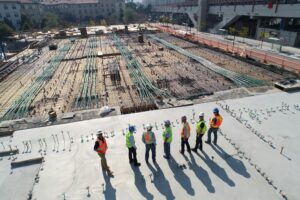Innovations in Prefabricated Construction: Efficiency and Modern Design


The construction industry is experiencing a transformative shift with the advent of prefabricated construction techniques. As the demand for affordable, sustainable, and rapidly deployable housing and commercial spaces increases, prefabricated construction emerges as a game-changer. This article delves into the innovative aspects of prefabricated buildings, highlighting their efficiency and modern design capabilities.
The Rise of Prefabricated Construction
Prefabricated or modular construction involves assembling building components in a factory setting before transporting and installing them on-site. This method contrasts with traditional construction, where most building activities occur on-site. Several factors, including the need for faster construction times, cost savings, and improved quality control, drive the shift towards prefabrication.
Efficiency: Speed and Cost-Effectiveness
One of the primary advantages of prefabricated construction is its efficiency. Traditional construction projects can take months or even years to complete, often plagued by weather delays, labor shortages, and logistical challenges. Prefabricated construction, on the other hand, significantly reduces construction time. By manufacturing building components in a controlled factory environment, projects can be completed 30-50% faster than traditional methods.
Another key benefit of prefabricated construction is its cost-effectiveness. The streamlined manufacturing process reduces labor costs and material waste. Additionally, the ability to standardize components allows for bulk purchasing materials, further driving down costs. This cost efficiency is particularly beneficial for affordable housing projects and commercial developments.
Quality Control and Durability
Quality control is a critical aspect of construction, and prefabrication offers superior quality assurance. Factory settings allow for rigorous quality checks at every stage of the manufacturing process. This controlled environment minimizes the risk of human error and ensures that each component meets stringent standards before being transported to the construction site.
Moreover, prefabricated buildings are often more durable than traditionally built structures. The precision of factory manufacturing allows for tighter construction tolerances, resulting in buildings that are more resistant to weather and seismic activities. Using high-quality materials and advanced manufacturing techniques further enhances the durability and longevity of prefabricated buildings.
Sustainability: A Greener Construction Method
Sustainability is a growing concern in the construction industry. The controlled factory environment reduces material waste through precise cutting and efficient resource use. The reduced construction time also translates to lower energy consumption and decreased emissions from on-site machinery.
Many prefabricated construction companies are also incorporating eco-friendly materials and energy-efficient designs into their projects. For instance, modular buildings can be outfitted with solar panels, green roofs, and energy-efficient HVAC systems. These sustainable practices reduce construction projects’ carbon footprint and promote environmental stewardship.
Modern Design Capabilities
Contrary to the misconception that prefabricated buildings are monotonous and uninspired, modern prefabricated construction offers a high degree of design flexibility. Advances in technology and manufacturing techniques enable architects and designers to create aesthetically pleasing and architecturally innovative buildings.
Prefabricated construction can accommodate designs from minimalist modern homes to complex multi-story commercial buildings. The modular nature of prefabrication allows for easy customization and scalability, enabling architects to experiment with different layouts, finishes, and materials. This versatility makes prefabricated construction suitable for various applications, including residential, commercial, educational, and healthcare facilities.
Innovations Driving Prefabricated Construction
Several innovations are propelling the growth and evolution of prefabricated construction. Building Information Modeling (BIM) is a crucial technology that enhances the design and construction process. BIM allows for creating detailed 3D models of buildings, facilitating better collaboration between architects, engineers, and construction teams. This technology ensures that all components fit together seamlessly, reducing the likelihood of errors and rework.
Another significant innovation is the use of robotics and automation in the manufacturing process. Automated machinery can perform cutting, welding, and assembly tasks with high precision and speed. This improves efficiency and ensures consistent quality across all building components.
The integration of smart technologies into prefabricated buildings is also gaining traction. Smart home systems, IoT devices, and advanced building management systems can be easily incorporated into modular buildings during manufacturing. These technologies enhance buildings’ functionality and energy efficiency, providing occupants with a comfortable and connected living or working environment.
Challenges and Future Prospects
Despite its numerous advantages, prefabricated construction faces some challenges. One of the main obstacles is the perception that prefabricated buildings are inferior to traditionally constructed ones. Educating stakeholders about the benefits and capabilities of prefabrication is crucial to overcoming this misconception.
Logistical challenges can also be solved, such as transporting large modules to the construction site and ensuring proper on-site assembly. However, advancements in transportation and crane technology are helping to mitigate these issues.
The future of prefabricated construction looks promising, with ongoing research and development driving continuous improvements. Integrating sustainable practices, advanced technologies, and innovative design solutions will further enhance the efficiency and appeal of prefabricated construction. As the industry evolves, prefabrication is poised to become a mainstream construction method, delivering high-quality, cost-effective, and environmentally friendly buildings.
Prefabricated construction represents a significant advancement in the industry, offering unparalleled efficiency, quality, and design flexibility. With its numerous benefits, including reduced construction time, cost savings, and sustainability, prefabricated construction is well-positioned to meet the growing demand for modern, high-quality buildings. As innovations continue to drive the industry forward, prefabricated construction will undoubtedly play a pivotal role in shaping the future of architecture and construction.
